
Let’s get ready to rumble in customer service. Our boxing ring is the telecom industry. The challenger in the red corner: a modern contact center. In the blue corner we have the veteran, the call center. It has prepared itself for this fight through an upgrade in digital transformation. The question is: who wins? The condition for victory is to offer each customer generation the communication channel that suits them best. And the price is a leading position in the saturated telecommunications market.
Before the ring is opened, here are some facts concerning competitive customers:
- 62% prefer human contact in customer support
- but 67% also expect digital channels
- costumers appreciate quick answers (51%) and competent staff (69%)
- agents also must meet high standards: concerns must be understood quickly, customer history must already be known, employees must be friendly
Source of figures: Springerprofessional
Can a call center meet today's ambivalent service requirements with digital transformation or is a contact center better equipped? Is a symbiosis of both the answer to excellent customer service? And why should providers have a look at different customer generations? Let us start.
Definition: Call center and its digital transformation

Following the description of businessdictonary a contact center is a "telephone service facility set up to handle a large number of (usually) both inbound and outbound calls. However, some firms specialize only in calls that are inbound (for assistance, help, or ordering) or outbound (for sales promotion or other messages). Most telephone orders are handled by call centers and not by the manufacturers or suppliers of goods or services."
But in the last years, call centers got an upgrade through digital transformation. Nowadays, they are supported by many useful digital tools. Here a selection what they use for the ring fight:
- telephone switch functionality: A telephone switch is a telecommunications system used in public switched telephone networks or large enterprises. It interconnects telephone subscriber lines or virtual circuits of digital systems to establish telephone calls between subscribers.
- intelligent routing: This technology is also called skills-based routing. It is used to gather customer inquiries through voice, digital, or social channels, and then applies rules to route it to the agent best fit to resolve the issue. The aim of intelligent routing is to reduce the customers time on hold and being transferred.
- automatic call distribution (ACD): The caller's number is analyzed or identified utilizing automatic number identification (ANI) and is forwarded to a specific agent depending on priority (VIP customer, private customer, new customer). Callers who cannot be assigned to a consultant are switched to the desired department or the next available agent.
- Interactive voice responding (IVR): In contrast to the ACD, the IVR directs the caller to the right contact person according to their needs using a dialogue query.
Definition: Contact center

Following the description of businessdictonary a contact center is a "customer service facility that houses all inbound and outbound communication channels of a firm (phone, voice-mail, fax, email, website, regular mail)."
So far, so good! But what are the big differences between a contact center and a call center? And are they fighting each other?
The ring fight: call center vs. contact center

Round 1: Omnichannel
So, a contact center handles inbound and outbound calls but also serves on digital channels. Services may include texts, webchat, video chat, social media, mail, and more. And it is likely to use cloud services and voice over internet protocol (VoIP) to let people communicate in their channel of choice. In a contact center, communication channels are part of the same integrated systems. Customers can switch to a new channel without disrupting service because they are supported by advanced technology and are operable from each agent's desktop. In a call center, agents mostly communicate via phone (and mail) and use some (or all) of the digital tools explained above, like IVR or ACD. So, they handle two non-connected communication channels (mail and phone). They do not know which services were provided to a customer from another agent or in another channel. Omnichannel is also not possible with just two channels. So, the first round goes to the contact center!
Round 2: Consistent brand image
To create a consistent brand image, you need a visual voice with logos, colours, and style in your marketing actions, website, social media, and so on. Also, a unique message, tone of voice, and consistently good service performance regardless of which contact point a customer uses to request a service. A contact center works in an omnichannel environment. It can provide a consistent brand image through a seamless service performance, and by showing the visual voice on social media, web, or app self-service. It is more challenging to generate a consistent brand image for call agents as they handle two non-connected communication channels (mail and phone). Also, they have fewer possibilities to show the visual voice of a telco company. BUT they have the human factor! If the agents have the same tone of voice and consistently good service performance, this creates a high brand image. So, the second round goes to … both!
Round 3: Proactivity
With new tools and analytics, customer service can go beyond answering inbound requests. Watching customer behavior makes it possible to reach out and answer questions even before a call comes in. Contact center solutions let customers choose how they want to stay in contact, making proactive communication an effective way to reduce costs and raise loyalty. Artificial intelligence can enhance the service even further by analysing data, taking over editorial activities, or providing the next best actions (proposed solutions). A call center takes a different approach: A customer contacts it if he or she already has a problem, such as a slow internet connection or no internet. Proactivity is usually not possible. Round three also goes to the contact center.
Round 4: Self-service
In a contact center, self-service can also be performed in several ways: With chatbots, live chats, search functions, or FAQs. Contact center software compiles all customer data from across all channels into a single customer view. With that customer information on hand, it is easier to route customers to the most appropriate representative or group. That is possible for both call centers and contact centers. But a contact center software pulls data from multiple channels, making it easier to predict where the call, text, web chat, etc. should go next. In contrast: a call center does not offer the possibility for a self-service. A customer is bound by the opening hours, and so he or she perhaps must wait for a whole long weekend to get an issue solved. And if the issue is a TV problem, a call agent may have an angry customer waiting in the line on Monday. This round also goes to the contact center.
Round 5: IVR
A classic IVR serves as a digital assistant that operates over the phone via vocal prompts or keypad entries – like in a call center. A contact center IVR helps predict caller intent proactively and direct callers to the best agent or resolves the caller's needs without involving a human representative. The contact center is the winner, but the call center also gets the point.
If you are interested in more information: here you can find more differences between contact and call center and here are further examples for useful technologies in customer service.
Okay, the ring fight is going on, so let us look at the customer generations and their preferred service communication channels. Perhaps this information will influence the fight…
Customer generations and their service preferences
Telecommunication providers have a lot of customers, and they are segmented in VIP customers, new customers, regular customers, and so on. But telcos, did you ever segment your customer base by generations? Here is some information about the different customer generations and their preferred service channels.
Baby Boomer
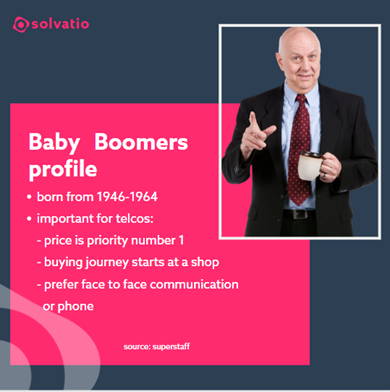
Source: superstaff
This generation was born between 1940-1950 or 1946-1964, depending on the classification. So, these are your customers between 80 and 56 years. Here are some facts to understand them and their customer service behavior:
- first generation growing up with TV
- other essential technologies were radio and cinema
- late adopter of the latest technologies
Baby boomers prefer traditional support: They like to solve service effectively, or product issues face to face in a local store or via the phone. Yes, they are an older generation and late adopters of new technologies, BUT this does not mean they are not tech-savvy: 68% have a smartphone, and more than half (59%) use social media.
So telcos here some takeaways to make this customer generation happy: You asking why? That is the customer group with the highest disposable income among the four generations, adjusting your customer service to meet their needs entirely is a no-brainer.
- reach them via traditional communication channels (shop, printed information, call center, and E-mail), BUT
- NOT only try to reach them via conventional channels: 86% do online research before buying a product
- invest in the call center service staff and accompanying technologies to generate happy baby boomer customers
- if you want to win customers out of this generation, offer them different products at discounted prices
Generation X

Source: superstaff
Generation X was born around 1965-1980, so they are mostly in their 40s. Here some facts:
- grew up with several technological advancements such as walkmans, VHS tapes, and cordless phones
- the first generation who used the internet for work in the 1980s and 1990s
So, what does this generation prefer in customer support? Email is the primary medium of communication, especially in a business-related context. That is where telcos should offer your deals. But when needing help with a problem, generation X consumers prefer to talk to a human. Please do not underestimate this group. They were not born in the digital age. Still, many of them have embraced today's technologies: They tend to keep social media, especially Facebook, LinkedIn, and Twitter, more for personal use than for business.
Have a short look at your CRM system: probably your generation X customers make up most of your long-term clients. So, with these tips you will make them happy and stay:
- provide this group with relevant information in advance via website or community portal
- satisfy this generation with good deals like quality products at reasonable prices and easy paths to purchase
- do not forget: Email is the primary medium of communication – that is where to offer your deals: 86% still bring in their mail every day
- efficient call center
Millennials /Generation Y
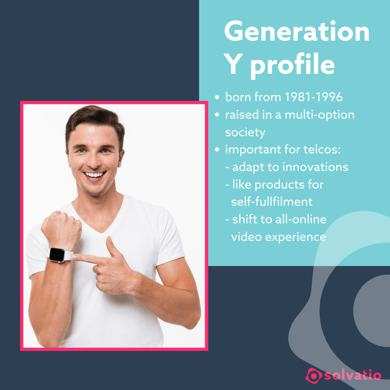
Source: superstaff
Generation Y, or also called Millennials, were born between 1981-1991. So, they are mostly in their 30s. Here the background to understand their service preferences:
- distinguishing criterion from the previous generation: they were raised in a multi-option society…
- …this enables them to adapt to changes and innovations
- they are the digital natives
Millennials belong to the Do-It-Yourself-Generation. They prefer FAQ and community forums over phone calls on customer service. They also like more personalized advertising, which is working only by giving up their personal data – they let a provider use their mobile data to personalize. If it comes to social media, their prior channels are Twitter, Facebook, and messenger. And: 81% of millennials use social media to interact with customer service. All members of this generation do not use live chat customer service, but numbers are growing. But the most important numbers: 60% of the millennial customers believe the wait time should be 5 minutes in customer service.
So, what can you do to fulfill that service requirement?
- update your self-service
- customer service should be accessible via social media
- bet on a good website
- offer service apps and live chat
Generation Z
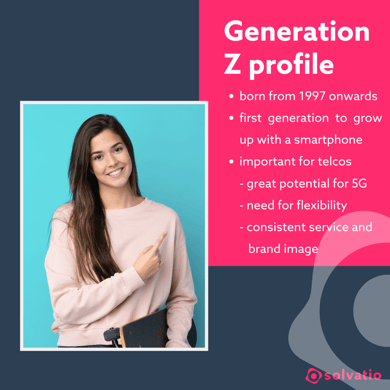
Source: superstaff
Generation Z is born between 1997-2010, so they are 10-23 and a mix of children, teens, and young adults. Here are some facts about this young generation:
- the first generation growing up with the smartphone
- real life has merged with digital transformation - they are always online
- trouble making decisions through all the digital offers and possibilities
Service plays an essential role for generation Z. They are used to receiving quick answers, requesting information ad hoc, and doing this on all channels. They are networking specifically with brands on social media - only 5% spontaneously choose a brand. When using chatbots, the inhibition threshold is much lower than within other generations: over 50% wish to communicate with such a bot. They found it an excellent alternative to usual customer care lines with higher acceptance than different generations. The brand image is also crucial for them - this context is above all ethical standards, the uniqueness of services, and quick support.
What does this mean for service providers should offer?
- focus on omnichannel
- bet on automation
- offer different service channels like chatbots and self-service
- be on social media for service requests but also brand image
Okay, let´s go back to the ring fight with this information in mind.
AND the winner is… a symbiosis of call and contact center
There is no real battle. There is no actual number one: A contact center cannot replace a call center – a contact center enhances a call center, taking it to the next level. It offers customers a variety of interlinked options. The winner is the symbiosis of contact and call center and digital transformation. For excellent customer experience, a provider needs a symbiosis of call and contact center - it is important that customer generations can choose their preferred way of communication. So, the support channels should be different, but seamless, and should pick up customers in their user behavior.
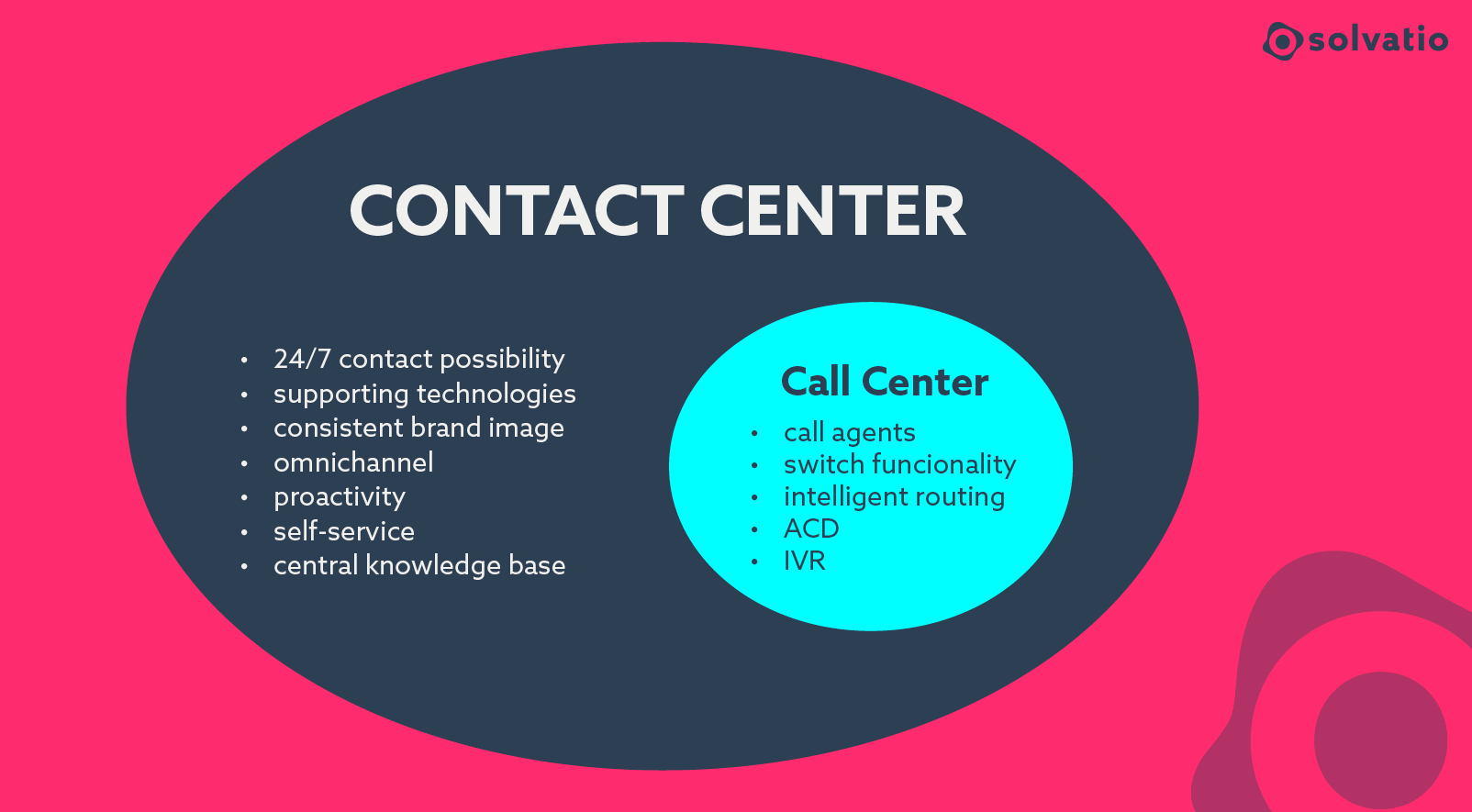
With practical employee training, customer profiling, and a CX strategy, exceptional experiences are possible with call centers and contact centers. In a contact center where those interactions come from calls, texts, and numerous other sources, there are more options to serve customers. A contact center is made up of truly connected, interactive solutions in a comprehensive technology ecosystem and offers omnichannel possibility. The system remembers interactions in one channel, even if a customer chooses a new channel next time. That gives customers far more freedom than with the call center model, and every interaction becomes a piece of the broader customer journey. A ture digital transformation!
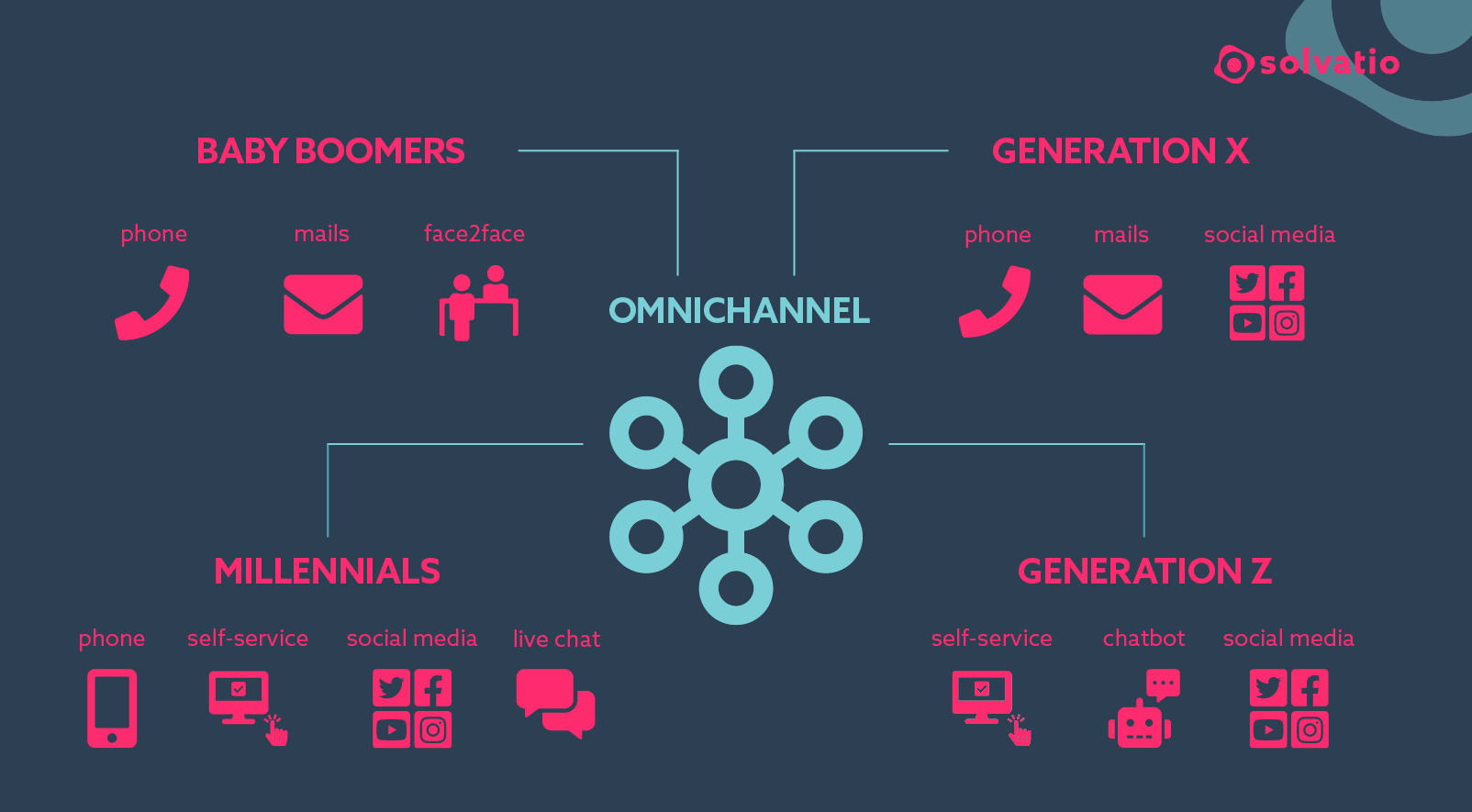
Not every digital communication channel is needed
Therefore, it is not only crucial for telecom companies to provide several support channels: channels also must perform well, i.e., be sensibly interlinked, offer adequate communication and information, and need independent competences (quick fixes, information transfer, and storage, ...). Even if the trend is towards digital channels, a modern contact center is not defined by the number of digital channels. Instead, it is determined by how well these channels are interlinked: they should have a uniform knowledge base and serve customer interests. The performance of channels also depends on the customers and their service behavior and preferences.
In the end – there should not be a ring fight between the call center with an upgrade in digital transformation and contact center. They are no challenger – they should work together in a symbiotic way for the condition of victory, offering each customer generation the communication channel that suits them best. So, they earn the price together: a leading position in the saturated telecommunications market.

